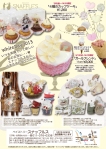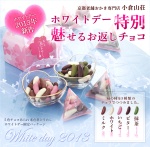UPDATE 1/10/14: Due to extreme flooding Oshogatsu has been postponed until Sunday, January 19, 2014. If you have already purchased tickets you will receive an email with details about your purchase. Otherwise, you may still purchase tickets online until Friday, January 17th at noon. We apologize for any inconvenience and hope to see you all there next Sunday!
With Part 2 of our New Year’s Blog series we want to talk about one of our favorite parts of any celebration – you guessed it – the food. Food plays an important part in celebrating the Japanese New Year; from Mochitsuki, rice-pounding to make mochi cakes, to special New Year’s eats, there’s a lot to taste and try when you visit us during Oshogatsu.
NEW YEAR’S FOODS
There are a few foods that are important symbols of good luck and happiness for the New Year. These special New Year’s foods are called osechi-ryori, and are traditionally packed in layered lacquer boxes called jubako, which are similar to bento boxes. The dish depends on the area, but some common dishes include kuromame (simmered black soy beans), kurikinton (mashed sweet potato with sweet chestnuts), tazukuri (candied dried sardines), renkon (lotus roots) and shrimp.
Each dish and ingredient holds meaning. Some dishes are said to bring good health, others a good harvest, happiness, prosperity, longevity, etc. Traditionally, yellow dishes and ingredients such as kazunoko (herring roe) symbolize prosperity, while mame (beans) are for good health. Usually, people make osechi dishes by New Year’s Eve to last through the first few days of the year so that they won’t have to cook during the celebration days.
At Morikami we’ll serve our own take on a few of these New Year’s flavors, as well as traditional mochi cakes straight from our the rice pounding ceremony. (We’ll also serve a few familiar American festival favorites.) No matter what, there will be plenty to taste!
NEW YEAR’S EATS AT OSHOGATSU
This year, as a special treat, the Cornell Café will serve a dish called chirashizushi. Traditionally, this is a festive dish served on special occasions, and loosely translates to “scattered sushi.” Ours includes tuna and salmon sashimi with shrimp, snow peas, carrots and a symbol of longevity in the new year – an origami crane. On festival grounds we’ll offer some other New Year’s eats like soba noodles and coconut shrimp!
Soba is a traditional noodle dish, made from buckwheat noodles in a hot soup, and symbolizes wishes for good luck in the year ahead. Shrimp is also an important symbolic food for New Year’s and is believed to promote longevity. Some say this is because shrimp have curved backs like the very elderly. Check out our food page as the event gets closer for more on what we’ll be serving up as well as full menus.
THE RICE POUNDING CEREMONY
Mochitsuki—the rice pounding ceremony – is essential to Oshogatsu, and is one of our favorite parts of the festivities. Traditionally, mochitsuki begins the day before by soaking the mochigome (sweet rice paste). The next day, the mochigome is ready to be steamed in the seiro (a wooden steaming frame) and then put into the usu, a large mortar made from wood, stone or concrete. The hot rice paste is then pounded with a kine ,a big wooden hammer, until smooth and shiny.
One of the most exciting parts of mochisutki is watching the cooperation between the person pounding and the person assisting (who quickly darts his or her hand into the usu and turns the rice before the next rhythmic pound of the hammer). It takes some coordination to get it right, but once the mochi is smooth and consistent in texture it’s placed onto a mochiko (sweet rice flour) covered surface, and small portions are pinched off, formed into balls, flattened and then set aside to cool until ready to eat.
At Morikami we perform the rice-pounding ceremony a few times throughout the day in order for everyone to get a chance to see and participate in the spectacle.
Tune in next week for a special New Year’s edition of Vlogs With Veljko where he’ll tell us about a very special Japanese New Year’s tradition- Nengajo!
This slideshow requires JavaScript.










